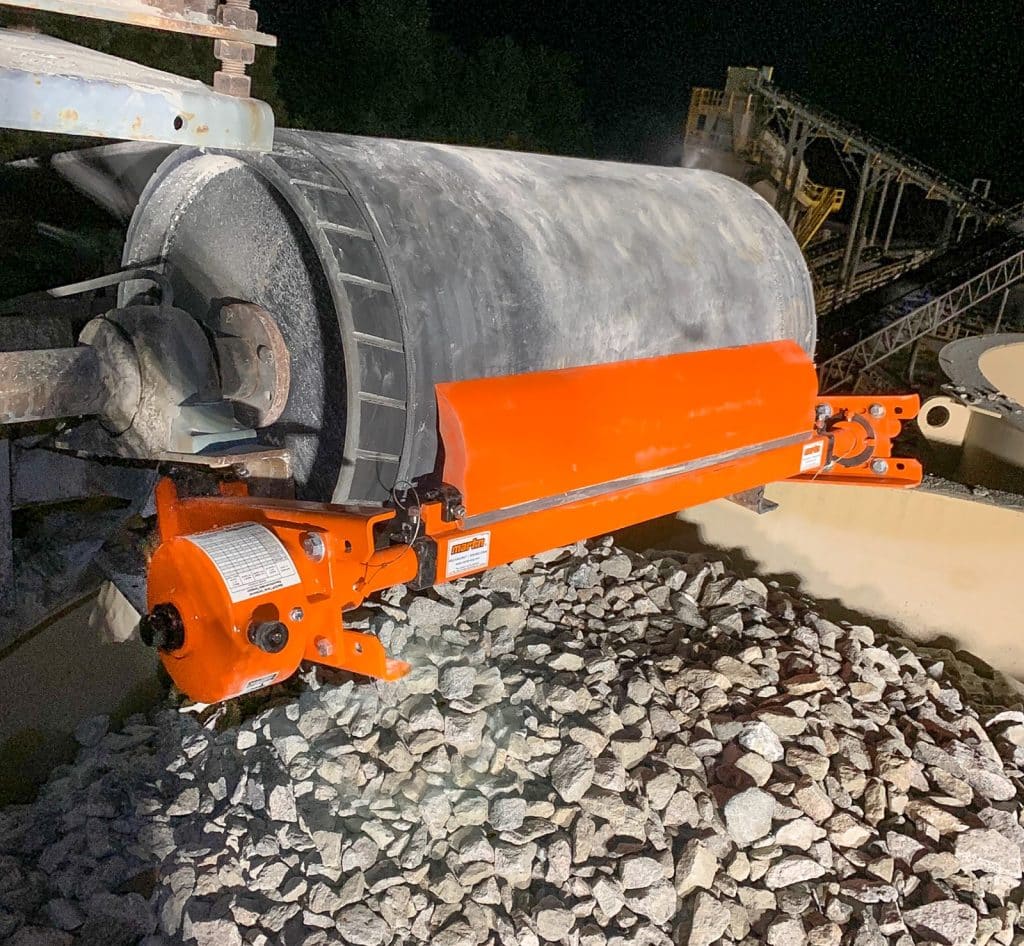Primary vs. Secondary Conveyor Belt Cleaners

Project and plant managers in the mining industry face the ongoing challenge of keeping conveyor belts clean. Dust and rocks can cause many problems, including worker injuries, compliance issues, and shortening the conveyor’s lifespan.
Primary and secondary conveyor belt cleaners are the answer to this problem. Their effective cleaning action helps maintain optimal conveyor performance. This results in fewer breakdowns and a smoother workflow.
Read on to learn more about primary and secondary conveyor belt cleaners.
UNDERSTANDING CONVEYOR BELT SCRAPERS IN MINING
In the mining world, conveyor belt cleaners are commonly known as “scrapers.” There are two types of scrapers: primary and secondary. Each type plays a specific role in maintaining the efficiency and cleanliness of the conveyor belt system.
PRIMARY CONVEYOR BELT CLEANERS: THE FIRST LINE OF DEFENSE
Scrapers are indispensable in maintaining mining industry conveyor belts. They are the first line of defense in a comprehensive cleaning system because they target the removal of material that can adversely affect the operation of the conveyor belt.
Here’s an in-depth look at their characteristics and benefits:
- Location and Function: Primary belt cleaners are installed at the head pulley on conveyor belts. Their purpose is to remove carryback, which refers to material left over that clings to the belt after discharge of transported material. This position is critical as it is the first contact point for conveying the material.
- Design and Efficiency: Engineers design these scrapers to withstand heavy use and aggressively remove significant amounts of material. Their sturdy construction helps to ensure long-term functionality and effectiveness.
- Operational Benefits: Primary scrapers prevent material buildup around the pulley and the belt, which is essential for the smooth operation of the conveyor system. The scrapers extend the conveyor belt’s lifespan and reduce hazardous material spillage along the path.
- Comparison to Secondary Cleaners: Primary scrapers play a critical role at the discharge point. Compared to secondary scrapers, they require a more robust design to handle larger volumes of material.
They serve as the first defense against carryback buildup. After the primary scrapers remove the bulk of material, the secondary scrapers perform finer cleaning tasks.
SECONDARY CONVEYOR BELT CLEANERS: THE FINISHING TOUCH
Secondary conveyor belt cleaners are integral to a well-rounded conveyor belt cleaning system in mining operations. Ensuring the conveyor belts are free of material buildup optimizes the efficiency and cleanliness of the full system.
Here are the specifics of their functionality and benefits:
- Position and Role: Positioned further along the conveyor line, secondary scrapers take over where the primary scrapers leave off. They specifically target and remove any leftover material the first scraper missed. This strategic positioning ensures a comprehensive cleaning process.
- Design for Precision: Compared to the more robust primary scrapers, secondary scrapers are designed with a lighter touch. This design allows for more precise and gentle cleaning, which is necessary to remove the finer carryback particles. Their less aggressive nature ensures they clean effectively without causing undue wear to the conveyor belt.
- Enhanced Cleaning Results: The strategic placement and specialized design of secondary scrapers resulted in a more thorough cleaning of the conveyor belt overall. By minimizing carryback thoroughly, the system’s overall cleanliness improves. This reduces needed maintenance and sustains operational efficiency.
- Differentiating Factors: What sets secondary scrapers apart is their lighter design and specific position on the conveyor system. They focus on fine-tuning the cleaning process by removing smaller amounts of material that the primary scrapers may miss.
This dual-scraping system ensures that the conveyor belt is as clean as possible, reducing the risk of material build-up and extending the lifespan of the belt.
The role of secondary conveyor belt cleaners in the mining industry cannot be overstated. They are essential for ensuring that conveyor belts are maintained at the highest cleanliness and efficiency standards, thereby supporting the overall productivity of mining operations.
THE SYNERGY OF PRIMARY AND SECONDARY CLEANERS
Using both primary and secondary belt cleaners offers a comprehensive cleaning solution crucial for maximizing conveyor efficiency. This dual approach ensures thorough cleaning, minimizes carryback, and reduces maintenance needs.
The key is determining if the added cost of secondary scrapers is worthwhile for managing residuals in a given system. Their use is tailored to the specific conditions and goals of each installation.
CUSTOMIZATION AND MAINTENANCE
Conveyor belt scrapers can be tailored to specific operational needs. Options include different materials for blades to suit various conveyor belts and environmental conditions. Scrapers can also be designed with adjustable mounting for precise blade positioning.
Regular maintenance is essential for optimal performance. The frequency of scraper replacement depends on the operational environment and the level of wear and tear. Scraper blades should be replaced when they are less effective at maintaining cleaning efficiency.
FREQUENTLY ASKED QUESTIONS
Here are some FAQs people commonly ask about conveyor scrapers:
Q: How do I choose between primary or secondary scrapers?
A: The choice depends on your system’s specific cleaning needs. Primary scrapers are essential for removing the bulk of carryback at the discharge point, while secondary scrapers handle additional cleaning further down the conveyor.
Q: What factors should I consider when purchasing scrapers?
A: Consider the type of material being conveyed, the conveyor belt’s size and type, environmental conditions, and the specific cleaning requirements of your operation.
Q: How often should scrapers be replaced?
The replacement frequency varies based on the environment and usage. Regular inspections will help determine when blades have worn down and need replacing.
WEST RIVER CONVEYORS: PIONEERS IN MINING CONVEYOR SOLUTIONS
West River Conveyors specializes in engineering and building custom mining conveyor systems. Our expertise spans from designing durable infrastructure to integrating customized components like belt scrapers to comprehensive material moving solutions. West River Conveyors is proud to offer a wide selection of high-quality primary and secondary belt scrapers from Martin Engineering. Explore our range of conveyor belt scrapers below to find the perfect fit for your mining operations.

